
Oxford Street is a major thoroughfare in Sydney, New South Wales, Australia, running from the south-east border of the Sydney central business district to Bondi Junction in the Eastern Suburbs. Close to the CBD in particular, the street is lined with numerous shops, bars and nightclubs. After the 1980s, Oxford Street garnered a reputation as Sydney's primary nightclub strip and subsequently saw a large increase in the number of crimes committed in the area. However, the 2014 lockout laws saw many nightclubs close and the crime rate drop as Sydney's nightlife hubs moved to Darling Harbour and Newtown. The lockout laws ended in 2020 with a focus on small bars and restaurants. Many nightclubs reopened in 2021 especially around Taylor Square.

Paddington is an upscale Eastern Suburb of Sydney, in the state of New South Wales, Australia. Located 3 kilometres (1.9 mi) east of the Sydney central business district, Paddington lies across two local government areas. The portion south of Oxford Street lies within the City of Sydney, while the portion north of Oxford Street lies within the Municipality of Woollahra. It is often colloquially referred to as "Paddo".

The Queen Victoria Building is a heritage-listed late-nineteenth-century building located at 429–481 George Street in the Sydney central business district, in the state of New South Wales, Australia. Designed by the architect George McRae, the Romanesque Revival building was constructed between 1893 and 1898 and is 30 metres (98 ft) wide by 190 metres (620 ft) long. The domes were built by Ritchie Brothers, a steel and metal company that also built trains, trams and farm equipment. The building fills a city block bounded by George, Market, York, and Druitt Streets. Designed as a marketplace, it was used for a variety of other purposes, underwent remodelling, and suffered decay until its restoration and return to its original use in the late twentieth century. The property is co-owned by the City of Sydney and Link REIT, and was added to the New South Wales State Heritage Register on 5 March 2010.

The Sydney Town Hall is a late 19th-century heritage-listed town hall building in the city of Sydney, the capital city of New South Wales, Australia, housing the chambers of the Lord Mayor of Sydney, council offices, and venues for meetings and functions. It is located at 483 George Street, in the Sydney central business district opposite the Queen Victoria Building and alongside St Andrew's Cathedral. Sited above the Town Hall station and between the city shopping and entertainment precincts, the steps of the Town Hall are a popular meeting place.

The Paddington Reservoir is a heritage-listed public park located at 255a Oxford Street in the inner eastern Sydney suburb of Paddington. It was designed by Edward Bell and built from 1864 to 1866 and operated as a water reservoir which accepted water from the Botany Swamps pumping station for supply to parts of Sydney between 1866 and 1899. In the twentieth century the site variously functioned as a service station and storage and mechanical workshop site. In 2006 work commenced to convert the site into a sunken garden and park. It is also known as Walter Read Reserve; Paddington Reservoir Gardens; Reservoir Gardens. The property is owned by City of Sydney. It was added to the New South Wales State Heritage Register on 2 April 1999.
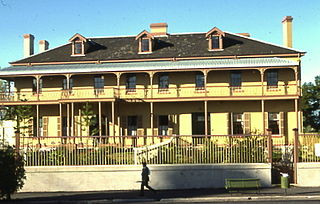
Juniper Hall, also known as Ormond House, is a heritage-listed former residence and children's home and now retail building and exhibition venue located at 1 Ormond Street, Paddington, Sydney, New South Wales, Australia. It was built from 1824 to 1825 by Robert Cooper. The two-storey Old Colonial Georgian house was added to the New South Wales State Heritage Register on 2 April 1999 and is listed on the Register of the National Estate
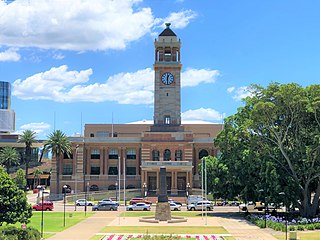
The Newcastle City Hall is a heritage-listed building located in the regional New South Wales city of Newcastle in the Hunter region in Australia. The building served as the city hall for the Council of the City of Newcastle between 1929 and 1977.
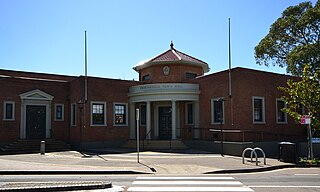
The Erskineville Town Hall is a landmark civic building in Erskineville, a suburb of Sydney. It stands at 104 Erskineville Road. It was opened in 1938 in the Inter-war Mediterranean style by Lindsay Gordon Scott. The Town Hall was the seat of Erskineville Municipal Council from 1938 to 1948 and was the seat of the South Sydney Councils from 1968 to 1982 and 1989 to 2003. Since 2004 the town hall has been a community centre for the City of Sydney servicing the local area and is listed as a heritage item of local significance by the City of Sydney.
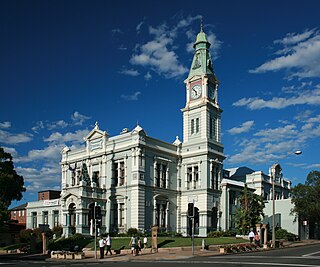
The Leichhardt Town Hall is a landmark civic building in Leichhardt, a suburb of Sydney, Australia. It stands at 107 Norton Street. It was built in 1888 in the Victorian Italianate style by architects Drake and Walcott. The Town Hall was the seat of Leichhardt Municipal Council from 1888 to 2016 and is now one of the seats of the new Inner West Council. The hall is listed on the Australian Register of the National Estate and the local government heritage database.

The Glebe Town Hall is a landmark civic building in Glebe, a suburb of Sydney, Australia. It stands at 160 St Johns Road and was built in 1880 in the Victorian Italianate style by architect Ambrose Thornley. The Town Hall was the seat of The Glebe Municipal Council from 1880 to 1948 when it became a community centre and hall run by the City of Sydney. After being transferred to the Municipality of Leichhardt in 1968, it was returned to the control of the City of Sydney following a boundary change on 8 May 2003.

The Paddington Post Office is a heritage-listed post office located at 246 Oxford Street in Paddington, a suburb of Sydney, Australia. The post office is owned and operated by Australia Post. The building was also a former telephone exchange. It was designed by the New South Wales Colonial Architect's Office under James Barnet and later Walter Liberty Vernon, and was built by William Farley. The building was added to the Commonwealth Heritage List, the New South Wales State Heritage Register on 22 December 2000, and the Register of the National Estate.

Wingham Memorial Town Hall is a heritage-listed town hall at 52 Farquhar Street, Wingham, Mid-Coast Council, New South Wales, Australia. It was designed by James T. Chambers and built from 1922 to 1924. It is also known as Wingham Town Hall and Wingham Council Chambers. The property is owned by Mid-Coast Council. It was added to the New South Wales State Heritage Register on 8 April 2016.

The Malachi Gilmore Memorial Hall is a heritage-listed former cinema and dance hall and now multi-use arts space at 124 Oberon Street, Oberon, Oberon Shire, New South Wales, Australia. It was designed by Virgil Cizzio or Bolton Millane from the firm of Agabiti & Millane and built from 1936 to 1937 by H. A. Taylor. It was also known as the Magna Theatre during the 1950s. The property is privately owned. It was added to the New South Wales State Heritage Register on 5 December 2003.

Wentworth Memorial Church is a heritage-listed former Anglican church building located at 32B Fitzwilliam Road, Vaucluse, Sydney, Australia. It was designed by Clarke Gazzard and Partners and built by Monteith Constructions, with Miller Milston and Ferris as engineers. The property is privately owned; and was formerly owned by the Anglican Diocese of Sydney. It was added to the New South Wales State Heritage Register on 25 September 2012.

The Canterbury Town Hall was an Australian municipal town hall located at 322 Canterbury Road in Canterbury, a suburb in the Inner West of Sydney, New South Wales. It was built in 1889 in the Victorian Free Classical architectural style by architect W. H. Monckton, and was officially opened on 11 April 1889 by the Prime Minister of New South Wales, Sir Henry Parkes. The Town Hall was the seat of Canterbury Municipal Council from 1889 to 1963. When the council moved to a new purpose-built administration centre on Beamish Street in Campsie, a recognition of the change in economic importance of Campsie, the town hall was quickly disposed of by Council and demolished, being replaced by a service station. Today the Town Hall site is part derelict and part paint shop.

The Randwick Presbyterian Church is a heritage-listed Presbyterian church located at 162 Alison Road in the Sydney suburb of Randwick in the City of Randwick local government area of New South Wales, Australia. The church was designed by Sir John Sulman and built from 1889 to 1890 by George Gale. The property is owned by the Randwick Presbyterian Church and was added to the New South Wales State Heritage Register on 8 May 2008.

Science House is a heritage-listed commercial building located at 157–169 Gloucester Street and Essex Street, in the inner city Sydney suburb of The Rocks in the City of Sydney local government area of New South Wales, Australia. It was designed by Peddle Thorp & Walker Architects and built in 1930 by John Grant and Sons, Master Builders. It was also known as Sports House from 1978–1991. The building is owned by Denwol, a property group owned and controlled by Phillip Wolanski AM. It was added to the New South Wales State Heritage Register on 10 May 2002.
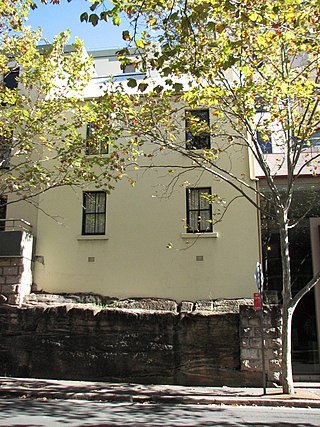
71 Harrington Street, The Rocks are heritage-listed serviced apartments and former terrace houses and shops located at 71 Harrington Street, in the inner city Sydney suburb of The Rocks in the City of Sydney local government area of New South Wales, Australia. It was built from 1860. It is also known as Sailors Return Hotel; Stafford Apts. and 75 Harrington Street; Clocktower Development. The property is owned by Property NSW, an agency of the Government of New South Wales. It was added to the New South Wales State Heritage Register on 10 May 2002.

The Trust Building is a heritage-listed office and commercial building and former hotel located at 72-72a Castlereagh Street, in the Sydney central business district, in the City of Sydney local government area of New South Wales, Australia. It was designed by firm Robertson & Marks and built from 1914 to 1916 by Stuart Brothers. It was added to the New South Wales State Heritage Register on 2 April 1999.























